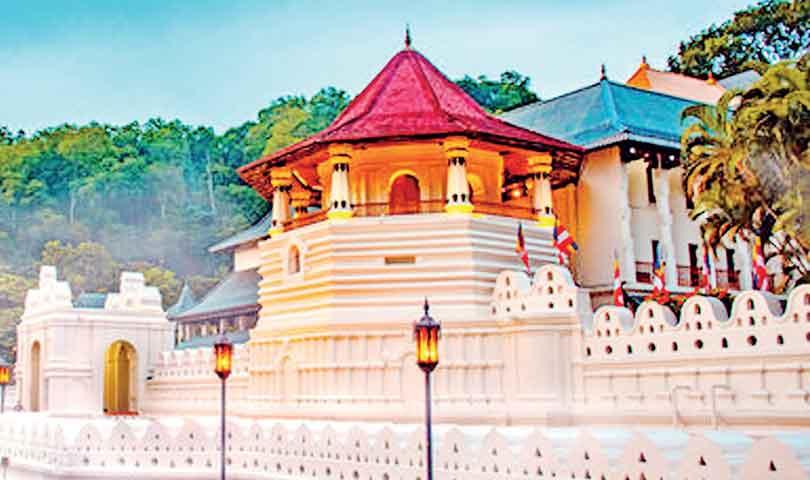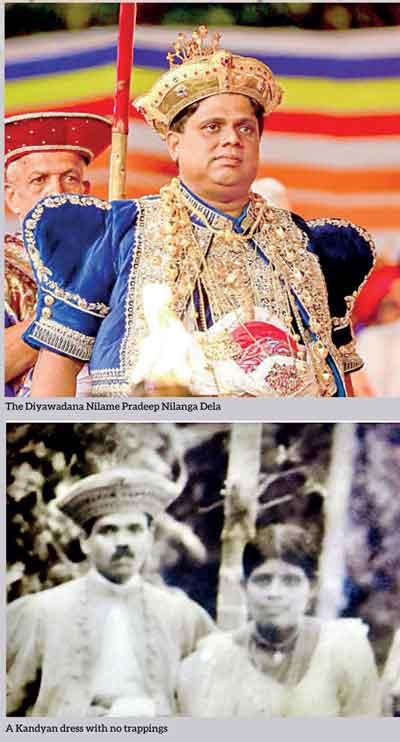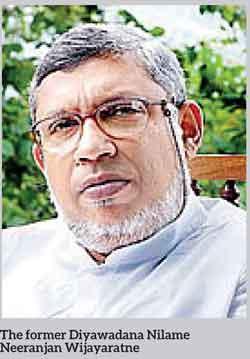Reply To:
Name - Reply Comment

 The former Diyawadana Nilame Neeranjan Wijayaratne who held office for twenty years and administered the Sri Dalada Maligawa for thirty years, and ten by his father Dr.Nissanka Wijayaratne said that it is appropriate to gazette the dances and other items of the Kandy Esala Perahera as requested by the incumbent Diyawadana Nilame Dela.
The former Diyawadana Nilame Neeranjan Wijayaratne who held office for twenty years and administered the Sri Dalada Maligawa for thirty years, and ten by his father Dr.Nissanka Wijayaratne said that it is appropriate to gazette the dances and other items of the Kandy Esala Perahera as requested by the incumbent Diyawadana Nilame Dela.
But, first the official dress of the Diyawadana Nilame and the Basnayake Nilames should be gazetted since the “Kandyan Dress” is being abused by many who have no right to wear the dress.
The former Adigar’s were the only people who wore ‘a long-sleeved ‘ jacket while the others wore the present dress as the ‘Kandyan dress’. The dress should be gazetted to be worn by only those entitled to wear, the Nilames of the Gazetted Devales and those whose parents had worn the dress earlier.
 The Kandyan Dress came from the Kings who were Dravidian rulers and they adopted it for their needs and this practice was followed by the Chiefs of the Kandyan Provinces who used it to visit the King in his court. This was adopted as the Kandyan dress.
The Kandyan Dress came from the Kings who were Dravidian rulers and they adopted it for their needs and this practice was followed by the Chiefs of the Kandyan Provinces who used it to visit the King in his court. This was adopted as the Kandyan dress.
The minor headman wore only the lower part of the dress as “ Thuppoti “ with a bare upper chest.
The ‘jacket ‘ of the Kandyan dress comes in various shapes and recently it carries a sword. The Kandyan dress doesn’t have a sword but a ‘Kasthana’ a short knife that they use to clean or root out any material. The sword is a new interpretation. If one could look into the old jacket, it was simple and well made, but now it has “shining amoury” and brocades all over making it very grotesque.
But, the most important fact is that one finds all types of Kandyan dress hung on showcases for hire. This has to stop said Neeranjan Wijayaratne. There are instances recorded where those wearing the dress were highly intoxicated and danced the ‘jigs’ and even fell drunk on the floor with the Kandy Dress which was hired.
There are only a handful of people who could prepare the dresses, but now this dress has been done in many ways, which is detrimental to the officials of the Devales and the Malgiawa. This is an official dress as an official dress of the security forces.
Then the “ Ves” dancers should also be regulated. They should not be allowed to ‘ summersault ‘ with the Ves dress as the ‘ Ves’ crown is the emblem of the deity of Kohomba Kankariya. Only those who wear the “Nieyandia” dance could if they wanted somersault without the “ Ves “ headdress. Today, students are enrolled in the “ Ves “ group for money which has to stop.
Somersaulting came when the Army formed an Eastern Band and had Ves dancers. They were prepared to summersault and it spread all over. Unfortunately, it was a Kandyan Army personnel who formed these dancers to summersault. This is done for fancy sake without realizing that they are infringing the rights of a God, added former Diyawadana Nilame Wijayaratne.
The Ves dress is the property of God Khomba and people not knowing these rites allow Ves dancers to summersault which is a disgrace to all and violates the holiness of Khomba Kankariaya.
The former Diyawadana Nilame was for the gazetting of the dancers and the type of music or what should be a part of this ancient ritual, though we now think in terms of a pageant, as the Kandy Esala Perahera, which he said was long overdue.
“Ves” dancing was introduced to the Kandyan Peraheras by Diyawadana Nilame T.B.Nugawela and various other dancing and musical items were introduced at various times.
When the first Perahera which was for God Natha was conducted around the Temple square there were only a few “Niyadi” dancers. Later it expanded and went out of control.
Former Diyawadana Nilame said that this move too should be “streamline” to bring decorum and dignity to the Kandy Esala Perahera.
It would be a tremendous task to get the Kandy Esala Perahera Gazzeted since it is a mass of people who are entwined in this gigantic Perahera.
The first account of the Perahera could be traced to Sir Robert Knox who lived in Kandy as a prisoner for 19 years and his account is fascinating.
 He must have been the first to be at the Perahera for God Natha and goes to describe the multitude of elephants, people, women and men who joined the Perahera. He speaks of around fifty elephants carrying the “ Painted Stick “, which is perhaps referring to the emblem of God Natha, the first Devale to be built in Kandy and close to the Maligawa.
He must have been the first to be at the Perahera for God Natha and goes to describe the multitude of elephants, people, women and men who joined the Perahera. He speaks of around fifty elephants carrying the “ Painted Stick “, which is perhaps referring to the emblem of God Natha, the first Devale to be built in Kandy and close to the Maligawa.
Then came a time with Sangharaja Weliwita, where monks paraded behind the tusker carrying the Sacred Tooth Relic which means that there was no Diyawadana Nilame and the monks guarded the Tooth Relic, rightly. (they do not parade the Relic anymore during the Perahera. The Diyawadana Nilame takes their place). No one knows how the monks gave up this practice and are not joining the Perahera anymore.
Then it was only in 1919, that the drummers who performed within the Maligawa daily were allowed to participate in the Perahera. In this manner many new items and new dances have ‘ crept ‘ into the Perahera. Not that it should be stopped, but streamlined as suggested by the present incumbent. How he would do and could do is up to him.
But the effort is not easy task.